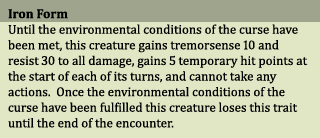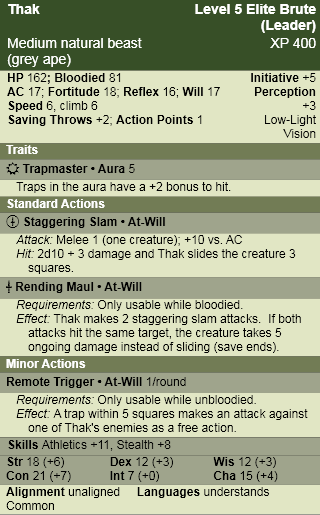Posts Tagged ‘4e’
The Flesh Mime and Other Belated Updates
September 24, 2011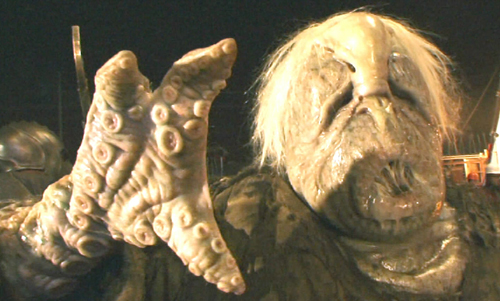 Ménage à Monster slowly stirs from its torpor, gathering the strength to birth more horrors into the world… But this isn’t a lame filler post (well not entirely) – unlike my last post, I actually have real content to present. It just happens to be on another website.
Ménage à Monster slowly stirs from its torpor, gathering the strength to birth more horrors into the world… But this isn’t a lame filler post (well not entirely) – unlike my last post, I actually have real content to present. It just happens to be on another website.
At the end of August, the good reptilians at Kobold Quarterly posted one of my creations on their website: the flesh mime.
I’ve never been completely satisfied with the direction 3e and 4e D&D took with the doppelganger. So I designed the flesh mime to move the monster away from being a sophisticated assassin infiltrating surface society, and return it to the predatory shapeshifter of the 1e Monster Manual that viewed humans as food. My second design goal was to make better use of the ‘spot the imposter’ trope (you know, ‘shoot both of us it’s the only way to be sure’) than the game had in the past, so flesh mime not only impersonates you and steals your abilities, but only the truly observant can tell you apart from the monster (I think that skills are an under-utilized dimension of 4e combat: ‘Insight, it’s not just for skill challenges anymore’).
The picture is J.J. Abrams’ updated version of the salt vampire from Star Trek (whose cameo was unfortunately cut from the finished film), which, it should be obvious by now, was one of the inspirations for the flesh mime.
While you’re at KQ, you should also check out the Nihilimentis, a monster I designed for them way back before Ménage à Monster existed. The Nihilimentis owes its inspiration to another monster from a long running SF show – the weeping angels from Doctor Who. I’m proud of the risks I took with this creature, but keep in mind that it was created before the Dungeon Master’s Guide II, so the damage output needs to be tweaked a little to use it in current games.
In house news, unpacking is just about done, and despite problems with the closing (which I’m told is not out of the ordinary), and the city digging a giant hole in our driveway on the day we took possession (not quite as normal), my partner and I are settling in very nicely. The city even fixed our driveway this week which is good, because I was half expecting the aforementioned giant hole to start spawning hordes of tiny stop-motion animated demons like the ones from The Gate. I hope there aren’t any zombie workers trapped in our walls – drywalling after they break out is a pain in the ass.
Shadows in the Moonlight – Part Two
July 16, 2011The Shadow in the Trees is the second creature from Robert E. Howard’s story, Shadows in the Moonlight. For the summary of that tale, as well as the iron shadow monster theme, click here.
This is also the second of Howard’s man-eating grey apes that I’ve featured in this series. The first, Thak, appeared in Rogues in the House (and before I’ve finished with Howard’s stories, there will be at least one more).
Spoiler Alert! All of these Hyborian age posts are going to be filled with spoilers. From the summary, to the monster stats they are going to ruin any surprises as to what the monster is, when they pop up in the story and how and why they are killed. You’ve been warned.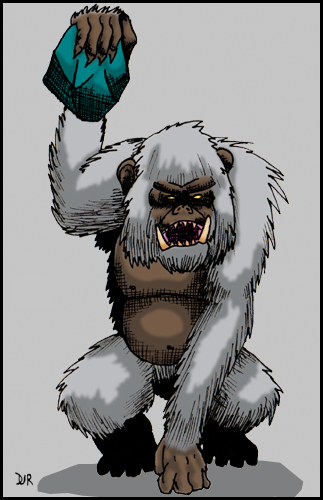
The Shadow in the Trees
“In general outline it was not unlike a man. But its face, limned in the bright moonlight, was bestial, with close set ears, flaring nostrils, and a great flabby-lipped mouth in which gleamed white tusk-like fangs. It was covered in shaggy grayish hair, shot with silver which shone in the moonlight, and its great misshapen paws hung nearly to the earth.” – Robert E. Howard, Shadows in the Moonlight.
Lore
Nature DC 15: Grey apes are a brutal and savage species of carnivorous primate that dwell in lonely mountains and hills. Their minds are more developed than true apes, and they often employ crude tools and weapons, though they are no less capable of ripping an enemy apart with their bare hands. It is prophesized that grey apes will one day evolve into a species that will challenge humanity for dominance.
Nature DC 20: Some grey apes have honed the skill of rock throwing to such a degree that they can rebound a single stone between two targets. These apes hide caches of projectiles throughout their hunting grounds, each carefully chosen for its weight and balance. Against large groups of enemies, grey apes hurl massive chunks of brittle stone that explode in a shower of painful and debilitating shrapnel.
The Shadow in the Tree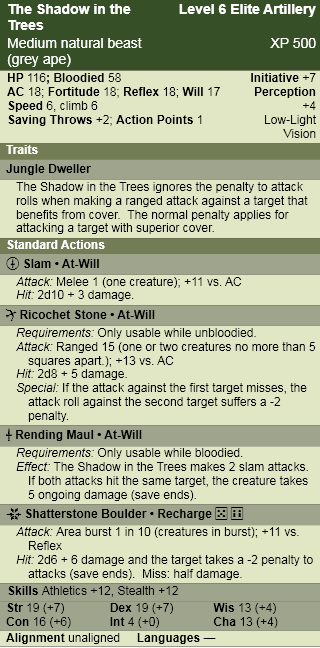 s in combat
s in combat
The Shadow in the Trees is a wary and cunning hunter. From behind a barricade of natural cover, or difficult terrain, it surprises its prey with a veritable barrage of hurled missiles. Only when its broken victims have stopped screaming, does the carnivorous ape move in to feed.
Like all grey apes, the Shadow in the Trees is prone to fits of bestial anger. When wounded, the ape is possessed with a homicidal fury, dropping its weapons and abandoning caution to rip and tear the source of its pain to bloody shreds.
Encounters
The shadow in the trees is drawn to ancient, vine choked jungle dungeons, where crumbling walls and loose flagstones provide the creature with ample ammunition. These forays bring the ape into contact with a wide assortment of strange creatures. In such an environment, the adaptable grey ape will utilize mindless denizens, like oozes and undead, as a natural bulwark against attackers. In turn, more organized creatures, like bugbears and gnolls, are eager to press a creature like the Shadow in the Trees into service with steady bribes of raw meat.
Notes
My main goal with the Shadow in the Trees was to extrapolate on the mechanical design of Thak, the first grey ape, without making a carbon copy. I like that Thak is essentially two creatures in one – a leader who relies on traps who transforms into a straight hand to hand brute when it becomes bloodied. That way, halfway through the fight, the creature’s altered tactics keep the players on their toes.
I continued that theme when I made the Shadow in the Trees. It’s an artillery creature that avoids melee characters, who transforms into a hand to hand brute that rushes into the thick of the fight (cribbing its bloodied attack from Thak which I thought provided a nice mechanical thread between the two monsters). The coolest part is how well this approach reflects the events of the story (the beast spends most of the tale hurling rocks from the concealment of the forest, only to emerge and confront Conan directly when its volatile rage gets the better of it).
When I create the next grey ape (which is about 8 stories away – so not anytime soon), I’m definitely going to continue with this pattern. One of the things I love about the 4e bloodied mechanic is that it lends itself so well to these Jekyll and Hyde type transformations (though I guess in the case of the grey apes it’s Hyde and Hyder).
Shadows in the Moonlight- Part One
June 21, 2011There is a lot for DMs to learn in Shadows in the Moonlight. In D&D terms, the island where the action of the story takes place is definitely a location based adventure, but it is also an amazing example of what game designers call a ‘living dungeon’ – one where the actions of the PCs influence the actions of the NPCs and both react to the island’s set encounters.
This story has the added bonus of a female character who subtly subverts the whole damsel in distress motif that was bothering me a few stories ago. Yes, Olivia is a damsel in distress, but she’s also capable of driving the plot forward on her own, and is more than just a prize to be won by the Cimmerian at the end of the story. In fact, although told in the third person, the story is obviously from Olivia’s point of view, making her the reader’s ‘eyes’.
Spoiler Alert! All of these Hyborian age posts are going to be filled with spoilers. From the summary, to the monster stats they are going to ruin any surprises as to what the monster is, when they pop up in the story and how and why they are killed. You’ve been warned.
Summary
Howard’s tale begins with Olivia, daughter of the King of Ophir, sold into slavery because she would not marry a King of Koth, fleeing her former master, the Hyrkanian Shah Amurath. On the swampy boundary of the Vilayet Sea, Shah Amurath reaches his quarry. As fate would have it, the salt marsh is also the temporary refuge of Conan, himself fleeing from Shah Amurath’s troops who had recently slaughtered the Cimmerian’s rogue mercenary army, the Free Companions. Mad with starvation and a burning desire for revenge, Conan throws himself at Amurath. The Hyrkanian’s superior weapons and armour pale before the furious onslaught of the barbarian, and in a few bloody moments of mad butchery he is cut down. His bloodlust sated, Conan returns to his senses and introduces himself to Olivia. Soon after, the pair decides to escape in a stolen rowboat before they are caught red handed by the deceased Shah’s men.
After a day of hard rowing, Conan lands the craft on a small deserted island to rest and gather some food. It isn’t long before they are ambushed by a huge hunk of hurled stone. Conan investigates, and after a few moments draws his weapon, grabs his companion and slowly backs out of the trees. Whatever it is that had unnerved the barbarian, Olivia cannot see it.
Moving through the island’s grassy hills, the two stumble upon the ruins of an ancient building. Eager to get as far from the jungle as possible, Conan and Olivia enter. Inside they find the hall of the long, low building is filled with incredibly lifelike iron statues of unsettling humanoids. The sculptures are disturbing, but poking and prodding reveal them to be as solid as they appear. Safe from their mysterious jungle stalker, Conan and Olivia drift off to sleep.
Instead of blissful rest, Olivia is plagued with an incredibly realistic nightmare. She sees the building as it once was, filled with the humanoids depicted in the statues. They torment a beautiful angelic figure chained to a pillar. To no avail, the angel creature wails to the heavens. A moment later, the dark humanoids open its throat in bloody sacrifice. Suddenly, the skies open wide and a being that could only be described as an exquisite and terrible god steps down among the savages. Cradling the body of its slain progeny, the god pronounces a powerful curse in its alien tongue. The humanoids freeze, transfixed, their bodies metamorphosed into solid iron. The deity then points to the moon, hanging in the night sky, and departs.
Olivia wakes screaming, and despite Conan’s protests that the statues are harmless, manages to convince the barbarian to leave at once. As frightened as she is about the iron figures coming back to life, Conan is more concerned about whatever lurks in the concealing jungle, so the pair take refuge on the island’s rocky cliffs.
The next day, from their high vantage point, Conan spies a pirate ship pulling ashore, spilling its ragtag occupants in search of supplies. The barbarian knows the ship is the best opportunity to safely leave the island and be rid of the Hyrkanians, so he hatches a scheme. In case his plan doesn’t work, Olivia hides while Conan confronts the pirates of the red brotherhood.
Unfortunately, the leader of the pirates is already well acquainted with Conan, and has a score to settle. Outnumbered, Conan goads the pirate captain into single combat, and handily slays him. Before he can parlay the victory into something more, an overzealous pirate brains Conan with a sling stone. Without the iron hand of a leader to guide them, the red brotherhood argues amongst themselves over the fate of the unconscious and bleeding Cimmerian.
Unaware of Olivia, the pirates bind Conan and drag him back to the ruins, where they set up camp for the night. Fearing the coming evil of the moonrise, Olivia braves both the jagged cliff face and pursuit by the shadowy stalker that has hounded them since their arrival. Inside the ruins, she creeps past the sleeping and drunken pirates to free Conan and escape.
They do not make it far when they finally meet Olivia’s pursuer face to face. Their mysterious assailant emerges from the shadows; a bestial man-eating grey ape. It was time for a reckoning in the only manner that Conan knew how. Barbarian and beast clash, but with the advantage of steel, Conan leaves the ape a broken and dismembered corpse.
The jungle brute was dead, but the island had yet to play its final hand. From the ruins came a series of bloodcurdling screams, the clash of steel, and the sound of unbridled butchery. Olivia’s dream had come to pass – the moonlight had just reached the crumbling building. Not eager to see the nightmare first hand, Olivia and Conan take flight to the pirate’s abandoned ship.
The morning light brings a small group of wounded and shaken pirates who managed to escape the massacre with their lives. Conan allows them to board what was once their ship – provided they acknowledge him as their captain. With a ship and a crew to replace the Free Companions, Conan was ready once again to plunder his way to vengeance across the inland sea.
Iron Shadow
“They were statues, apparently of iron, black and shining as if continually polished. They were life-sized, depicting tall, lithely powerful men, with cruel hawk-like faces. They were naked, and every swell, depression and contour of joint and sinew was represented with incredible realism. But the most life-like feature was their proud, intolerant faces.” – Robert E. Howard, Shadows in the Moonlight.
When the gods are angered the world trembles. When there is a blasphemy so obscene it demands justice, such as the ritual murder of a deity’s demigod offspring, the gods do not act through proxies, and iron shadows are left in their wake.
Iron shadows are the product of an ancient divine curse, transformed into metal statues to guard over the site of their cosmic crime until the end of time. As such, they are usually found in the crumbling remains of prehistoric dungeons, the ruins of primordial temples, and on blasted mountain peaks shunned by all sentient races. They are immobile, forced to watch without being able to act, until an environmental condition, laid out at the time of their cursing is satisfied. Such a condition could be anything from the light of the moon to a breath of air in a subterranean chamber, but once it has been met, the iron shadows are temporarily transformed back into flesh and blood creatures; free to release centuries of bottled hatred on any unfortunate enough to cross their path.
Only the gods themselves know why they would allow the objects of their curse even the briefest freedom from punishment. Perhaps the terror iron shadows invoke serves as a reminder to the world the consequences for the ultimate blasphemy.
Only the most depraved of the thinking races have incurred this divine curse, including black ones, derro, drow, gnolls, goblins, humans, kuo-toa, and troglodytes. Some iron shadows are so old that they have outlived their decadent civilizations, and even the names of their species are lost to the sands of time.
The iron shadow theme adds an element of lurker to any monster, and works best on a group of creatures in a set-piece encounter that reinforces the blasphemous act that offended the divine. Alternatively, iron shadow themed monsters work well in an area the characters must travel through frequently, and have been lulled into a false sense of security by the statues’ prior inactivity.
Skill Modifications: +2 bonus to Stealth, and a +2 bonus to one of the following knowledge skills – Arcana, Dungeoneering, History or Religion.
Traits
All iron shadows gain the following trait, which simulates their cursed sta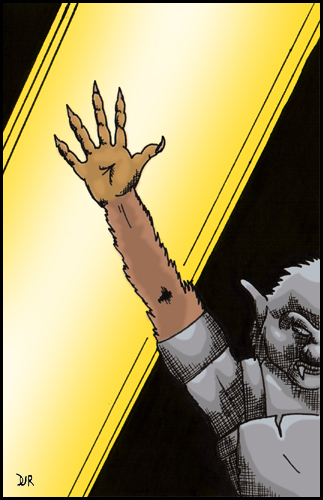 te:
te:
Attack Powers
The nature of their curse means that Iron Shadows most often attack from surprise, surrounding their foes and bringing down the weakest targets as quickly as possible. Although the survivors of such an onslaught often flee, the divine magic of the iron shadows’ curse binds them to the area and prevents pursuit.
Fearsome Aspect
This power emphasises the sudden and frightening nature of an iron shadow attack. It works best in an encounter area that directly blocks the characters’ objective, since all or some of the party may be forced to flee.
This power makes the opening attack of a lurker even more devastating, or adds an element of lurker to any other monster role.
Relive the Nightmare
When added to a lurker (or other creature with bonuses against targets that grant combat advantage), this power helps to increase damage potential. Relive the nightmare also gives the dungeon master the opportunity to describe the events surrounding the iron shadow’s curse, and inject pieces of narrative into the combat.
Utility Powers
Iron shadow utility powers focus on keeping lurkers and artillery alive long enough to cause the maximum amount of damage.
Centuries in Iron
Over time, some iron shadows have learned to harness the deific curse to their own advantage. This protective power is especially useful for lurkers and artillery that are prone to succumbing to the effects of focused damage.
Palpable Hatred
This power helps to protect artillery from melee combatants, keep skirmishers mobile and prevent lurkers from being surrounded by foes.
Notes
Wow, I’ve never made a theme before and I have to admit it was a lot more work than I thought it would be (much more than creating a single monster, which in hindsight makes sense). Of course, the fact that the battle with the monsters isn’t directly described in the story didn’t help either. Still, I think making a theme to represent the isle of iron statues was definitely the right choice. This way, almost any creature can be turned in to what amounts to an iron gargoyle – which I think has a lot more utility than a single similar monster.
I’m pretty sure that the statue creatures in the story are the black ones from the Pool of the Black One (their physical description is comparable as well as the strange green stone of their buildings). I find the presence of these creatures in both stories very interesting for what it means about the setting of the Hyborian age. In his essays, as well as the Conan and Kull stories, Howard writes at length about the ancient civilizations of the serpent people, Stygia and Acheron, but he makes no mention of the black ones. Being present as far west as the Atlantic, and as far east as the Vilayet, suggests remnant pockets of what at one time must have been a much more widespread race (plus the green stone of the city of Xuthal in the south suggests that they may have been the original builders), probably incredibly old even in Kull’s time, before Atlantis sunk beneath the waves. A quick internet search reveals I’m not the first person to question the relation between these stories, but it’s still an interesting point to ponder nonetheless.
Random Encounters: Ilya Ivanov, real life Dr. Moreau
June 10, 2011I’ve always thought the RPG Blog Carnival was a cool idea – a group of writers coming together just for the fun of exploring an interesting theme (like a digital flash mob); but the topics covered so far have been outside of the focus of this site. Fortunately, this month’s host for the carnival, Dungeon’s Master, have set a theme I can really sink my teeth into: RPG characters based on real life people (using no less awesome an example than Seth Grahame-Smith’s Abraham Lincoln, Vampire Slayer).
Growing up, my father, an electrical engineer, taught me a healthy respect for alternating current, so naturally my first choice was Nikola Tesla, but Greg at Lungfishopolis beat me to the punch. So I decided to move on to another, lesser known eastern European ‘mad scientist ’, Ilya Ivanov.
’, Ilya Ivanov.
Ilya Ivanov was a Russian biologist who worked from the turn of the century until the early 1930’s. He pioneered revolutionary artificial insemination techniques and used the technology to create a wide variety of hybrids, including zebra-donkey, antelope-cow, and rabbit-guinea pig mixes (hello owlbear!). As if that wasn’t enough RPG fodder, Ivanov is most infamous for his efforts to create a human-ape hybrid. His first attempts using apes impregnated with human sperm failed. Logically then, the next step was to impregnate human females with ape sperm. In spite of actually having a volunteer willing to carry the hybrid, Ilya Ivanov was arrested in one of Stalin’s shakedowns of the Russian scientific community before he could get the experiment underway. As far as I know, Stalin had no moral objection to human-ape crossbreeds, and the arrest was a purely political one. Ivanov never got a chance to return to his mad work, dying in exile in Kazakhstan in 1932.
Not surprisingly, since then Ivanov pops up regularly in conspiracy theories, fringe science, and pop culture every few years (or the shadow of his ideas do). The forbidden and frightening act of creating a human hybrid, mixed with the sinister exoticism of Stalinist Russia is a brew too powerful to resist. Seriously, we’re talking about an army of cold war, soviet, super apes! That’s pure gold.
The legacy of Ilya Ivanov can be felt in the classic Fantastic Four villain Red Ghost (and his super apes), in DC’s Gorilla Grodd, and in the Planet of the Apes movies (including the soon to be released reboot, Rise of the Planet of the Apes).
Taking my cue from Seth Grahame-Smith, I’m going to use a similar over the top approach; one that posits Ivanov succeeding where h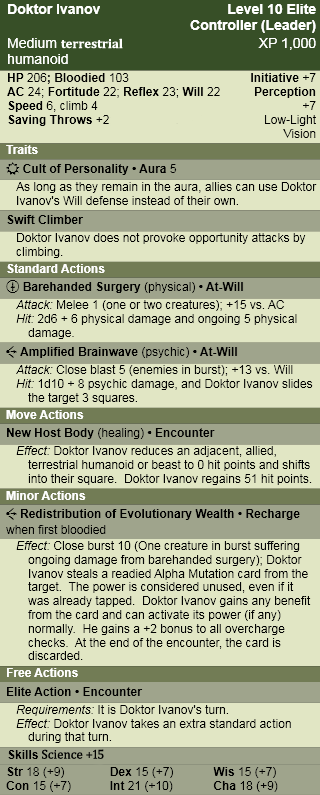 istory tells us he failed. And I can think of no better RPG suited to house Ilya Ivanov than one already filled with mutant animals, a blatant disregard for the laws of nature and bucket loads of cold war sensibility: Gamma World.
istory tells us he failed. And I can think of no better RPG suited to house Ilya Ivanov than one already filled with mutant animals, a blatant disregard for the laws of nature and bucket loads of cold war sensibility: Gamma World.
I present, for use with the current edition of Gamma World (as well as Dungeons and Dragons), Ilya Ivanov and his super apes.
United Soviet Simian Republic
“Species of the world, unite! (Literally)”
Ilya Ivanov was a soviet scientist who worked to create the first human-ape hybrid. In most realities he failed and was arrested by Stalin, but in a few, the mad visionary was able to escape imprisonment and create an army of super apes. With his hybrid commandoes, Ivanov quickly overthrew Stalin and carved out a new Soviet empire. Ivanov, in his role as dictator, ushered in an age of undreamed scientific progress untainted by political ideology, and unfettered by morality or ethics.
By the time of the Big Mistake, Ivanov had ‘outgrown’ his old, perishing body and had transferred his brain to a series of simian hosts.
Doktor Ivanov
“You know how I know that monkey is smart? I can see its brain.”
Doktor Ivanov lost the last shreds of his empathy when he abandoned his human body and put his brain in a jar. Now he views everything through the cold, detached lens of a science experiment. In combat Ivanov uses his bestial strength to rip raw hunks of meat out of his opponents, analyze their genetic imprints, and absorb any beneficial mutations found for further study. Should his host body become damaged in his pursuit of test subjects, Doktor Ivanov doesn’t hesitate to transfer his brain to one of his humanzee ‘children’. That the process decapitates the host doesn’t seem to bother either Ivanov or his creations.
Humanzee Shock Trooper
“To err is human, to ape divine.”
Humanzees combine humanity’s capacity for war and violence with the strength and agility of an ape. They are the perfect soldiers, and ob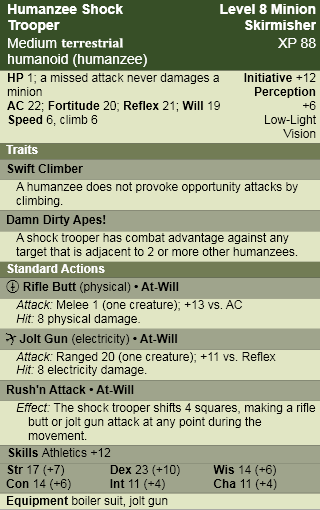 ey strong commanders without question so long as there is war to wage. Even on Gamma Terra, there is little more horrifying than seeing the raw hatred and naked brutality of a swarm of boiler suited humanzees washing over their foes like a crimson tidal wave.
ey strong commanders without question so long as there is war to wage. Even on Gamma Terra, there is little more horrifying than seeing the raw hatred and naked brutality of a swarm of boiler suited humanzees washing over their foes like a crimson tidal wave.
LoreAlthough he built his empire with the savage power of human-ape hybrids (and they remain his most successful creation), Doktor Ivanov experimented with many other human –animal combinations. With the proliferation of creatures such as badders, hoops, dabbers, fen, and porkers wandering the wastes one has to wonder if prevailing origin theories are wrong and these beasts are actually the orphaned offspring of Ivanov’s abandoned experiments.
Notes
I did it. I made another ape monster even though I promised I would keep them to a minimum. I really did want to stat-up Tesla, and when I was looking around for other real life mad scientists to replace him Ivanov just jumped out at me. I’m glad I broke my promise though, I really like how everything came together (there were a few Gamma World monsters that affected the use of Alpha and Omega cards but nothing that took advantage of the card mechanic itself, so I wanted to incorporate that into the design). Plus, I really wasn’t happy with how the picture for Thak turned out, and I wanted another shot at drawing a primate before the next instalment of Monsters of the Hyborian Age.
Incidentally, the brain in a jar aspect of the monster was inspired by another Russian, a contemporary named Sergei Bryukhonenko, who invented a heart and lung machine that could keep a dog’s head alive and responsive detached from its body. I’m sure Ivanov would have had access to that technology during his soviet renaissance of scientific research.
Rogues in the House
May 28, 2011Beyond being a great crime/horror story, Rogues in the House is especially interesting to gamers as an example of the literary roots of D&D’s city adventures. While the obvious choice for such inspiration is Fafhrd and the Grey Mouser’s adventures in Lankhmar, I think that Rogues in the House provides a darker and grittier counterpoint to Fritz Leiber’s more whimsical tales. Thievery, corruption, political intrigue, backstabbing, and assassination – this story has more than enough fodder for any DM looking to mine ideas for urban adventures.
Spoiler Alert! All of these Hyborian age posts are going to be filled with spoilers. From the summary, to the monster stats they are going to ruin any surprises as to what the monster is, when they pop up in the story and how and why they are killed. You’ve been warned.
Summary
The events of this tale take place not long after The Tower of the Elephant, featuring a somewhat wiser Conan, though no less wild and dangerous.
The story begins with the subtle and deadly political manoeuvrings of Murilo, a young and ambitious noble selling the secrets of his city to the enemy, and Nabonidus, a Red Priest who uses his religious position to control the city’s ruler for his own personal gain. Nabonidus sends Murilo a message, a gilded box with the ear of one of the nobleman’s confederates. Clearly, Murilo has been marked for death. In need of a hired sword to assassinate the Red Priest before his enemy can strike, Murilo seeks out Conan, who has earned a dangerous reputation in the city’s slum.
Luckily for Murillo, Conan has been imprisoned for the murder of a different priest (who happens to be a double crossing fence), and is in need of a favour to avoid the headsman’s axe. Conan agrees without hesitation to Murilo’s bargain – in exchange for his freedom he will kill Nabonidus before the sun rises.
Unfortunately for both men, the guard that Murilo had bribed to free the Cimmerian is arrested before completing his task. Overcome with panic, Murilo grabs a sword and heads to the Red Priest’s estate to deal with Nabonidus personally. Once there, he finds the guards have already been slain, yet not by human hands. Eventually he finds Nabonidus slumped over a table, his features hidden by the enveloping folds of his signature red cloak. Stealthily Murillo moves to strike, but the figure wheels around, revealing not the Red Priest but a hairy monster that quickly overpowers the noble and knocks him unconscious.
Meanwhile, Conan has escaped prison on his own, crushing his jailor’s skull with a joint of beef he had been eating (a classic move every warrior since has dreamed of repeating). Although there is nothing holding him to his bargain, he keeps it anyway, sneaking into Nabonidus’ abode through the sewers. There he encounters the first of the Red Priest’s traps – an iron portcullis that swings down, trapping the barbarian in the estate’s dungeons. It is not long before he runs into the shaken Murilo, and with little other choice, the two press on to find and slay their captor.
Eventually they cross paths with none other than Nabonidus himself, recovering from a blow to the head and trapped within his own dungeon. After some back and forth a truce is called (against Conan’s instincts to simply kill the Red Priest and be done with it). Nabonidus and Murilo agree to forget their transgressions against one another and cooperate in order to escape. It seems that the beast the young noble encountered wearing Nabonidus’ robe is Thak, the Red Priest’s pet grey ape. Nabonidus raised the creature from a cub and trained it to be his bodyguard and servant, but it turned against him this night and slew the rest of his minions.
Nabonidus leads the pair to the only exit from their dank prison, a door that leads back up to the building above. Before they leave, Nabonidus uses a series of periscopes he has hidden in the dungeon to spy on the chamber above, confirming his worst fears. Thak is waiting patiently for them. But what is worse than facing the creature’s brute strength is that he has mastered the household’s deadly traps. The Red Priest assures Conan and Murilo that to open the door while the ape watches is certain death.
While the trio debates their next course of action, another faction enters the tale, inadvertently breaking the stalemate. Through the periscope Nabonidus detects a group of nationalists stealing into the chamber, weapons drawn, the second party of the night with the Red Priest’s assassination on their minds. Surprising them as it had Murilo earlier; Thak catches them off guard and activates one of Nabonidus’ pitiless traps. Before they can react, t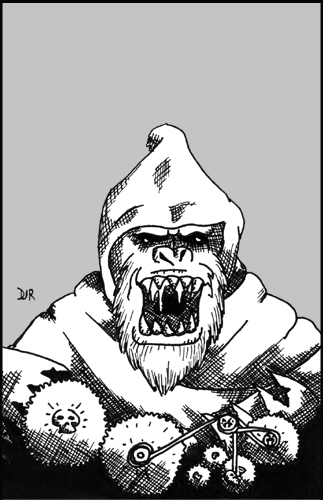 he nationalists are levelled by grey lotus powder.
he nationalists are levelled by grey lotus powder.
Just as his master had taught him, Thak drags away the bodies to conceal his crime. Knowing they will have few opportunities, Conan, Nabonidus and Murilo sprint into the room before the ape returns. The trio may have avoided the deadly trap, but escape from the killer ape is another matter entirely. In order to finally vanquish their tormentor Murilo acts as a decoy while Conan waits in ambush. Barbarian and beast meet in a contest of unbridled primal fury, with Thak ultimately succumbing to the repeated blows of Conan’s poniard.
However, there is one final play to be made. Nabonidus seizes the opportunity to do away with his enemies by grabbing the pull cord for one of his unsprung traps. Conan and Murilo completely in his power, the Red Priest gloats over his victims. But his triumphal celebration is premature. Moving like a panther, Conan grabs a nearby stool and hurls it at Nabonidus’ head with such force that it snaps the man’s neck.
The pair finally leaves the accursed house of the Red Priest – Murilo to his political ambition, and Conan to the unencumbered adventure of the highway.
Thak
“The body was thick, broad and stooped. The unnaturally wide shoulders had burst the scarlet gown… The face peering from the scarlet hood was utterly bestial, and yet Murilo realized that Nabonidus had spoken the truth when he said that Thak was not wholly a beast.” – Robert E. Howard, Rogues in the House.
Nature DC 15: Grey apes are a brutal and savage species of carnivorous primate that dwell in lonely mountains and hills. Their minds are more developed than true apes, and they often employ crude tools and weapons, though they are no less capable of ripping an enemy apart with their bare hands. It is prophesized that grey apes will one day evolve into a species that will challenge humanity for dominance.
Nature DC 20: Unscrupulous criminals often take advantage of the grey ape’s near human intellect by training them as terrifying and savage guards. Some specimens have even learned the art of trap-making. Such creatures are dangerous to own, as they resent captivity and often use their skills against the masters who taught them.
Thak in Combat
Thak’s intelligence allows him to employ strategies in combat few would expect from a bestial ape. Using techniques mimicked from his human master, Thak attacks from ambush, activating traps and hurling enemies into pitfalls and other hazards. Once wounded though, Thak’s animalistic nature takes control, and the ape becomes consumed with a rage that only tearing into his enemies bare handed can sate.
Encounters
Thak is equally at home in a pack of his brethren surrounded by crude jungle-forged snares as he is guarding a sophisticated thieves’ den with intricate magical and mechanical traps.
Notes
The first of many apes! Seriously, Robert E. Howard really liked Conan to face off against primates, and the stories are filled with them. So much so, that when I first told one of my friends about the Monsters of the Hyborian Age project he figured it would just be a compendium of apes. I guess the whole ‘missing link’ thing fit well with weird fantasy and made them more frightening than regular humans or animals (in an uncanny valley way).
Mechanically, I figured that since traps in 4e work essentially like monsters, than the best bet would be to make Thak a Leader and have his ally enhancing abilities work for traps instead of creatures. Since remotely activating a trap essentially gives him another attack, I made him an elite.
I will try my hardest to make the various simian creatures of Howard’s stories different enough to warrant a separate stat-block and prevent this series from turning into ‘candy apple island’. Just a warning though – the next story also features one of the infamous grey apes, but it looks like Shadows in the Moonlight is going to generate a two-parter, so at least it won’t be all ape.
Random Encounters: Put on a Grey Ribbon
May 21, 2011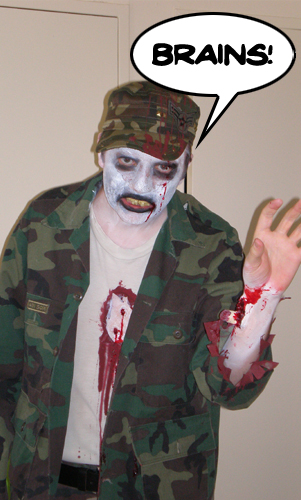 Thanks to myths and monsters week on Daily Planet, I discovered that May is Zombie Awareness month. According to the Zombie Research Society (who I guess are the ones who decided this… I wonder if they have a government grant?), the month of May was chosen because:
Thanks to myths and monsters week on Daily Planet, I discovered that May is Zombie Awareness month. According to the Zombie Research Society (who I guess are the ones who decided this… I wonder if they have a government grant?), the month of May was chosen because:
“Many films important to the evolution of the modern zombie are set in the month of May, from the original Night of the Living Dead, 1968, to the well received Dawn of The Dead remake of 2004. Also, because spring naturally brings with it a sense of renewal and hopefulness, May is the perfect month to emphasize continued vigilance in the face of the coming zombie pandemic.”
Well, as the picture can attest to (circa the 2008 Toronto Zombie Walk); I’m certainly not unaware of the coming zombie apocalypse (in the future, undead Canadians will look at me dressed up in that picture and be offended). And even though I’ve never really talked about the undead on this blog (hey, where’s the underwater beholder awareness month?), they are an important ingredient to any ménage à monster.
That said, zombie awareness month actually got me thinking about something else – fake undead (maybe it was the photo). During the days of 1st edition D&D (and bleeding over into 2nd), there was a popular trend of ‘gotcha’ monster design. That is, monsters that look like something they are not to trick adventurers into using ineffective tactics against them. The best example of this is probably the gas spore – a monster that looked just like a beholder, but exploded in a cloud of deadly spores if you panicked and hit it with a weapon (I happen to like the gas spore – but it probably has more to do with nostalgia and the sweet Trampier illustration than good design), but it was by no means the only one. That’s where the fake undead come in. These were a category of gotcha monsters that looked like undead (and sometimes acted like it too)… but weren’t. So while your party’s cleric was busy wasting time trying to turn undead, it was killing the rest of you in some non-undead way.
Now some people like using this kind of monster, and maybe I’ve been brainwashed by post 3rd edition thinking, but these creatures just strike me as cheesy one-shot adversaries designed solely to exploit the game’s mechanical assumptions. But complaining about the design choices of monsters from the dustbin of D&D’s history doesn’t get us anywhere. If Zak from Playing D&D with Pornstars can rehabilitate the gas spore, then perhaps some of D&D’s fake undead can be salvaged as well:
- Adherer (from Fiend Folio): This humanoid was covered in loose folds of flesh that made it look like a mummy. It secreted glue from its skin that made your weapons stick to it (I actually did use this monster in 2e, more for its sticky power than its resemblance to a mummy). Surprisingly, this monster has already been rehabilitated – by Paizo in their book Misfit Monsters Redeemed. Here they are presented as living relics of a horrible experiment conducted by phase spiders on the ethereal plane.
- Drelb (Monster Manual II): A creature native to the plane of negative energy that looks like a wraith, and is summoned to guard an area or treasure. It cannot be turned, but tricks clerics who try to do so by appearing to move away, but actually shrinks and moves forward. The drelb’s special power is as lame a
 s a monster that attacks by pretending its going down a flight of stairs. To rehabilitate it I’d get rid of the shrinking thing and quit making it imitate wraiths. Now it’s a malevolent blot of pure necrotic energy that can only manifest in the zone it was summoned to protect (using a mechanic like 4e homunculi). To keep its anti-clerical theme it could do something bad (like an attack or imposing a condition) to anyone who used a power in its aura with the radiant keyword (or someone who used a healing power instead).
s a monster that attacks by pretending its going down a flight of stairs. To rehabilitate it I’d get rid of the shrinking thing and quit making it imitate wraiths. Now it’s a malevolent blot of pure necrotic energy that can only manifest in the zone it was summoned to protect (using a mechanic like 4e homunculi). To keep its anti-clerical theme it could do something bad (like an attack or imposing a condition) to anyone who used a power in its aura with the radiant keyword (or someone who used a healing power instead). - Gambado (from Fiend Folio): This one-legged creature uses a discarded skull as a head prosthetic, digs a hole in the ground, and when some adventurer comes to investigate the skull, it jumps out at them. I’m amazed this thing survived two editions of the game. I’d take away the ambush predator aspect of this monster and instead focus on the bone stealing and collecting. Reimagined, it becomes a sort of necromantic caddisfly that forms a cocoon out of bones. It can animate its grisly shell to move around the battlefield and attack. Perhaps absorbing new bones heals it, or maybe the gambado grows weaker as its protective cocoon is shattered (yes the name comes from ‘leaping and springing’, I guess it could leap out at you and try to bite your face off it its cocoon is destroyed).
- Necrophidius (from Fiend Folio) and Yellow Musk Zombie (from Monster Manual II): OK, neither one of these monsters really needs to be rehabilitated. With the addition of knowledge checks to the game in 3e, these go from gotcha to cool. Construct made out of snake bones that can hypnotize you by swaying back and forth? Awesome. Killer plant that controls you by planting a seed in your head? Even more awesome. I’m willing to admit when my idea falls apart.
- Pseudo-Undead (from Monster Manual II): The worst culprits of the lot, pseudo-undead are humanoids that look like undead, but have none of their special abilities. Like a Scooby-Doo villain, they spend their pathetic lives hoping others will be too scared to attack them. Here’s a tidbit: “Pseudowraiths and pseudospectres cannot fly but walk so lightly as to leave no trace, and are often thought (unless closely observed) to be floating above the surface, although this is an illusion.” Like the gambado, this is going to take a bit of a stretch. First I’d call the creature something different, like a necroclone. Then, taking a bit of inspiration from the myrmarachne melanotarsa, the monster becomes a shapeshifter with a taste for rotting, undead flesh. It can mimic corporeal undead so fully (and is resistant to disease and necrotic damage) that it lives among colonies of ghouls, and packs of zombies. These are not only the necroclone’s preferred food source, but they also provide the monster with protection, since few other monsters would target a large group of dangerous undead.
That covers 1e’s core monster books, but I’m sure later supplements, as well as Dragon and White Dwarf, hold more examples. Maybe someday I’ll even get around to statting these beasts up.
Classic Monsters: Eye of the Deep
May 13, 2011Note: ‘Classic’ is a pretty subjective term, and when I use it here I mean to say: monsters that have survived through the editions of D&D that I think are cool. In this series of articles I look at the development of a classic monster over time and try to add a ‘crunchy’ piece of my own to the creature’s canon.
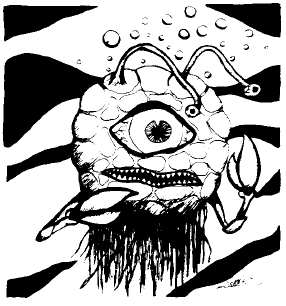 The eye of the deep, the beholder’s unloved cousin, has long held a special fascination for me. As I’ve mentioned previously, when I was a kid who didn’t know any better, flipping through my older brother’s copy of the Monster Manual, this critter caught my eye. Until I had been playing the game for some time, I mistakenly believed that the eye of the deep was a more powerful version of the beholder, since it had eye rays and giant lobster claws (lobster claws were the tentacles of the eighties). Even when I had been properly schooled in D&D lore, my initial impressions of this monster insured it would regularly surface from my subconscious any time I found myself staring down into water that was too deep to see the bottom (well, the eye of the deep and those giant tube worms from the G.I. Joe episodes with the MASS device).
The eye of the deep, the beholder’s unloved cousin, has long held a special fascination for me. As I’ve mentioned previously, when I was a kid who didn’t know any better, flipping through my older brother’s copy of the Monster Manual, this critter caught my eye. Until I had been playing the game for some time, I mistakenly believed that the eye of the deep was a more powerful version of the beholder, since it had eye rays and giant lobster claws (lobster claws were the tentacles of the eighties). Even when I had been properly schooled in D&D lore, my initial impressions of this monster insured it would regularly surface from my subconscious any time I found myself staring down into water that was too deep to see the bottom (well, the eye of the deep and those giant tube worms from the G.I. Joe episodes with the MASS device).
I admit, I’ve never used the eye of the deep in a game. I’m not really sure why. It could have been because I’ve never ran a game that focused on water encounters. Or it could be because(as far as I’m aware), the eye of the deep was never used in a single published adventure, not even in 2nd edition’s monstrous arcana series focused on beholders and beholder-kin (Eye of Pain, Eye of Doom, and Eye to Eye). Then again, it took until 3.5 edition for me to use a regular beholder in an encounter (and no one would argue with its icon status), so I hardly think that’s a strike against it.
Possible Origins?
This is a bit of a non sequitur in an already long article, but I’ve always wondered if the character of Alpha Centauri from Doctor Who had anything to do with the inspiration for the eye of the deep. It does resemble the creature, and it did air in the Curse of Peladon serial in 1972, 5 years before the eye’s appearance in D&D.
1st Edition
While the beholder made its debut in the pages of the Greyhawk supplement for OD&D, the eye of the deep didn’t make it into the game until 1977’s Monster Manual. It has the distinction of being the very first in a long line of beholder variants the game acquired over the years. The book establishes the eye of the deep as a 3-5 foot diameter sphere (size large in AD&D), with a pair of crab-like pincers, a large central eye and a pair of eyestalks. The main eye can emit a blinding flash that stuns opponents, while the smaller eyes can work together to create illusions or cast hold monster and hold person independently.
In Dragon Magazine’s The Ecology of the Eye of the Deep, none other than Ed Greenwood expands on the creature’s lore. The meat of the article describes the creature’s reproductive cycle (they’re hermaphrodites), its hunting habits (it uses its illusion powers to lure prey close and then stuns them with its central eye), and even scientific tidbits about its physiology (the eye of the deep cannot rise to the surface without the change in pressure causing it to explode). Greenwood also adds to the eye of the deep’s attacks, giving it the ability to grab onto opponents with its claws.
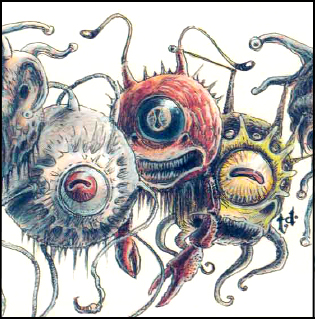 2nd Edition
2nd Edition
The eye of the deep next appears in 2nd edition D&D’s first volume of the Monstrous Compendium. Here it is presented as a variant of the beholder, but is otherwise almost identical to its AD&D version (although its size remains 3-5 feet in diameter, in this version of the game that makes it a small-medium size creature). Ed Greenwood’s grasping claw attack is not incorporated into the monster’s statistic block.
Late in the edition’s lifespan we are given another glimpse of the eye of the deep in the monstrous arcana supplement, I Tyrant. Although the creature gets only a short paragraph in the book, author Aaron Allston gives us a glimpse of the eye of the deep’s sociology: they communicate over long distances using the light flash from their central eye, and teach their offspring how to hunt using their ability to generate illusions (although this doesn’t really fit with Greenwood’s depiction of them randomly leaving eggs on the sea floor).
3rd Edition
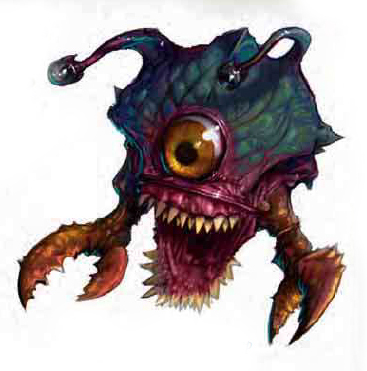 The eye of the deep isn’t updated until 3.5 edition’s Lords of Madness hardcover. In this incarnation the eye retains the ability to stun and blind with its central eye, hold monster, generate illusions, and even grab hold with its claws. It loses the ability to hold person (which makes sense since hold monster supersedes that ability in this edition), but gains the power to project a cone of cold. This edition also sees the first real size change in the creature, growing to a nine foot diameter, 6000 pound behemoth (large sized with the option to advance in hit dice to huge size).
The eye of the deep isn’t updated until 3.5 edition’s Lords of Madness hardcover. In this incarnation the eye retains the ability to stun and blind with its central eye, hold monster, generate illusions, and even grab hold with its claws. It loses the ability to hold person (which makes sense since hold monster supersedes that ability in this edition), but gains the power to project a cone of cold. This edition also sees the first real size change in the creature, growing to a nine foot diameter, 6000 pound behemoth (large sized with the option to advance in hit dice to huge size).
The behaviour of the eye of the deep generally conforms to previous editions (it uses illusions to lure and confuse prey), but the authors (Richard Baker, James Jacobs and Steven Winter) made one alteration that I think illustrates the changing philosophy of D&D game design. Instead of keeping a solitary vigil over shipwrecks at the bottom of the ocean (and exploding if it ascends), the Lords of Madness eye of the deep prefers to hunt on the surface. While this approach may be less realistic (we are talking about a giant floating eye with claws) than Greenwood’s, it’s a change that puts the monster in immediate and direct conflict with the PCs and thus makes it much more useful for DMs.
4th Edition
 It seems that the only legacy of this monster to penetrate the 4th edition of D&D has been the ‘eye of’ naming convention. Then again, the eye of the deep has not been singled out in its exclusion. It seems that the long list of beholder-kin from previous editions is one of the ‘sacred cows’ the designers of the game wished to slay. It seems though, that a long list of beholder variants isn’t what the designers had a problem with per se (the compendium currently holds 17 different variety of the monster). So I guess it was the specific variants themselves they didn’t like (some of them were pretty silly – I’m looking at you director)… Or maybe they just wanted to create something new. Regardless, I can’t let the snubbing of one of my favourite beasties stand, so I present to you this unofficial entry into 4th edition canon:
It seems that the only legacy of this monster to penetrate the 4th edition of D&D has been the ‘eye of’ naming convention. Then again, the eye of the deep has not been singled out in its exclusion. It seems that the long list of beholder-kin from previous editions is one of the ‘sacred cows’ the designers of the game wished to slay. It seems though, that a long list of beholder variants isn’t what the designers had a problem with per se (the compendium currently holds 17 different variety of the monster). So I guess it was the specific variants themselves they didn’t like (some of them were pretty silly – I’m looking at you director)… Or maybe they just wanted to create something new. Regardless, I can’t let the snubbing of one of my favourite beasties stand, so I present to you this unofficial entry into 4th edition canon:
Beholder Eye of the Deep
Not all beholders dwell in the twisted passages of the underdark. Some float in the lightless ocean depths, rising to the surface to terrorize and destroy any that dare cross their invisible territories.
Lore
Dungeoneering DC 15: Though they lack the sheer number of eye rays that other beholders possess, the eye of the deep compensates by way of strong grasping claws and the ability to generate illusions.
Encounters
Beholders are rarely willing to serve other creatures, and the eye of the deep is no exception. However, some eyes of the deep bully nearby sahuagin into servitude, using them as shock troops to subdue passing ships and coastal towns. The eye of the deep is a negligent master though, and over time the sahuagin invariably desert, fall in combat, or are eaten for food.
Eye of the Deep in Combat
The eye of the deep takes great pleasure in creating illusions to lure its prey in close. The cruel beasts create images of shipwreck survivors, mermaids, and anything else they think will draw their targets into the water. The eye of the deep always opens combat with a stunning blast of light from its central eye before ripping its helpless victim into digestible hunks with its claws.
The Pool of the Black One – Part Two
May 5, 2011 This is the second creature from Robert E. Howard’s The Pool of the Black One (well, sort of a creature). For the summary of the story as well as the black one thug and the voice of silence, click here.
This is the second creature from Robert E. Howard’s The Pool of the Black One (well, sort of a creature). For the summary of the story as well as the black one thug and the voice of silence, click here.
Spoiler Alert! All of these Hyborian age posts are going to be filled with spoilers. From the summary, to the monster stats they are going to ruin any surprises as to what the monster is, when they pop up in the story and how and why they are killed. You’ve been warned.
Emerald Pool of Sacrifice
The emerald pool of sacrifice plays an important role in the vile society of the black ones, both as a focal point for their infernal religion and as a torture device for their depraved amusement. The opaque, green fluid that fills the pool is suffused with anti-life. It strips away the life essence of those immersed in the water so violently that it leaves the body of the victim a small, compressed statuette with the consistency of petrified bone.
In their weird cities of green glass, the black ones spend generations collecting these grisly trophies. It is unknown what role they play in the creatures’ religion, but the black ones guard the remains of their victims with zeal.
Notes
There is a moment of horror in the story, when Conan realizes that the rows of statuettes were once people, which I thought would work perfectly for a D&D encounter. Petrification is a staple of the game, but it’s hard to get that feeling of dawning dread anymore – the medusa’s garden filled with statuary is cool, but a cliché that players have come to expect. Despite the story being as old as it is, I thought its titular pool could add an interesting twist to petrification.
I made the pool peter out as it ran out of targets, which is counter to the story, but I wanted it to be useful for the widest variety of encounters. Alternatively, you could have the pool trigger a skill challenge after 10 rounds, simulating the PCs flight from the city of the black ones (the whole ‘running from the wave of lava’ thing). Of course, if you wanted this to be a plot point, you’d have to make sure that a creature sacrificed itself during combat, which, depending on how it was handled could seem overly heavy handed by some players.
The Pool of the Black One – Part One
March 19, 2011The Pool of the Black One is Howard’s first pirate themed Conan yarn (although Conan’s past as a pirate was hinted at in The Scarlet Citadel) and establishes the rivalry between the Zingaran freebooters and the Barachan pirates. It’s also a fun blending of weird fantasy and grimy, pirate adventure – an indispensable read for anyone who’s a fan of Green Ronin’s Freeport series of adventures.
Once again though, the female character is problematic and I think I’ve finally put my finger on what bothers me about Sancha (and Natala for that matter). It’s not the ownership of women (Howard uses slavery as one of his criticisms of ‘civilization’), or that every women jumps into Conan’s bed by the end (which intimates that the only currency women have is their bodies – but this is a well established pulp adventure trope that’s continued into the action movies of today so I can hardly single Howard out for that). What bothers me is when Howard’s female characters lack any agency, any way of impacting events in the world for themselves without attaching themselves to another character. Not all his female protagonists are like that, I guess with the last two stories in a row it was just getting to me a little.
Spoiler Alert! All of these Hyborian age posts are going to be filled with spoilers. From the summary, to the monster stats they are going to ruin any surprises as to what the monster is, when they pop up in the story and how and why they are killed. You’ve been warned.
Summary
The story begins with Conan fleeing the Barachan Isles on a leaking rowboat, and then making a swim for the first ship he sees – the Wastrel, captained by the freebooter Zaporavo. There is a tense moment between the men while the captain decides what to do with the Cimmerian. Ultimately, he chooses to let Conan join the crew instead of ordering his men to cut him down. This sets into motion a series of events that will see Zaporavo lose “his ship, his command, his girl, and his life.”
After a failed hazing from the rest of the crew that leaves the offender with a snapped neck, Conan soon earns their respect with his skill as a sailor and his prodigious strength. He also attracts the eye of Zaporavo’s concubine, Sancha.
Following clues left in the legendary scrolls of Skelos, Zaporavo heads into the uncharted west, in search of a forgotten civilization and its ancient treasures. Eventually the Wastrel reaches the forgotten island and Zaporavo orders his crew to stay near the shore and gather supplies while he searches the interior alone. Conan slips into the trees after the captain, bloody business on his mind, while the rest of the crew gorges on strange, golden fruit.
Conan soon reaches his quarry, and away from the prying eyes of the crew, duels Zaporavo for the Wastrel. After slaying the Zingaran, Conan continues inland, his curiosity piqued at his former captain’s quest for treasure. There he finds a strange city peopled by tall, mute, dark skinned creatures with diabolical features. From his hiding place he sees the creatures torture the Wastrel’s cabin boy and use a magical green pool to transmute him into a tiny, petrified statue.
While Conan weighs his options, he sees that the creatures have captured Sancha, as well as the rest of the crew, who are in a drugged stupor from eating the island’s fruit. The Cimmerian draws his blade and dives into combat, buying the rest of the freebooters enough time to get to their feet and for Sancha to get them their weap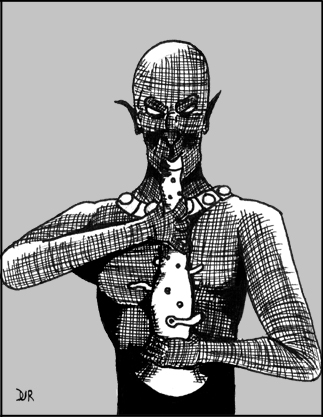 ons (I guess she isn’t completely helpless). A viscous melee follows, with losses on both sides, but the invaders have the advantage of numbers, and the dark skinned giants rout.
ons (I guess she isn’t completely helpless). A viscous melee follows, with losses on both sides, but the invaders have the advantage of numbers, and the dark skinned giants rout.
Cornered in front of the pool, the leader of the creatures breaks his silence in a howl of pure hatred and sacrifices himself into the mystic green waters. The pool erupts in a volcanic geyser, unleashing a sentient wave of death in the freebooters’ direction. Grabbing Sancha, Conan and the rest of the crew make a run for the shore, barely escaping the eerie green river chasing them.
Though ragged and bereft of any bounty, Conan has won the affections of Sancha, the Wastrel and a crew eager for the plunder of more populated waters.
Black Ones
“These creatures were black and naked, made like men, but the least of them, standing upright, would have towered head and shoulders above the tall pirate. They were rangy rather than massive, but were finely formed, with no suggestion of deformity or abnormality, save as their great height was abnormal. But even at that distance Conan sensed the basic diabolism of their features.” – Robert E. Howard, The Pool of the Black One.
Nature DC 15: The creatures known as the black ones are the result of a divergent offshoot of evolution, one that branched from humanity in the dim days of prehistory. There is a marked diabolical influence in their features, and it may be that the black ones are the result of infernal tampering, many ages before the creation of the Tiefling bloodline.
The black ones live in open air cities with glass-like walls, where they enact foul rituals and pursue strange pleasures in the name of their perverse religion. It is said these cities hold ancient knowledge and treasure for those brave enough to risk the black ones’ wrath.
Nature DC 20: The black ones have no spoken language and communicate with one another telepathically. Although it is possible for them to speak with other creatures in this manner, their disdain for all other intelligent life makes the idea repulsive to them. Legend holds that the leaders of the black ones are capable of vocalizing their hatred in an obscene howl that can blast their enemies.
Encounters
It is extremely rare to find the black ones cooperating with other intelligent races. They are xenophobic, whose only contact with other humanoids is to capture victims to sacrifice in infernal rituals. However, these rituals often bind assassin imps, spined devils, and pain devils into service. Though the concept of a pet is alien to them, the black ones have been known to use behemoths as living weapons when the need arises.
Black ones guard their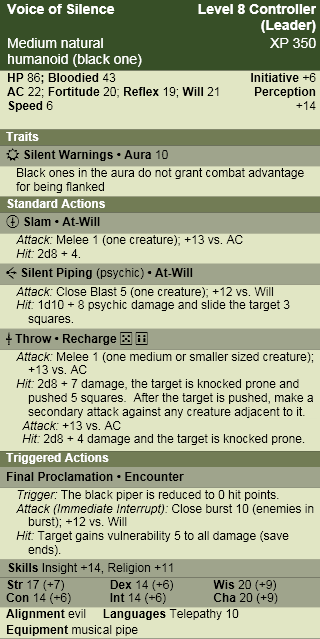 cities with magical traps and hazards, which often feature prominently in their religious practices and blasphemous entertainment.
cities with magical traps and hazards, which often feature prominently in their religious practices and blasphemous entertainment.
Black One Thug
“Conan knew that if he fell foul of that mass of taloned muscle and bone, there could be but one culmination. Once let them drag him down among them where they could reach him with their talons and use their greater body-weight to advantage, even his primitive ferocity would not prevail.” – Robert E. Howard, The Pool of the Black One.
Black One Thugs in Combat
Though they may appear as naked savages to the civilized eye, black one thugs are calm and collected in combat. They have no need for armor or weapons, their own bodies being sufficient to deal with the threats of their environment. When attacking, thugs select the most dangerous adversary in a group, surround, drag them to the ground, and mercilessly stomp the life out of them. Weaker foes are left alive to be captured for sacrifice and loathsome amusements.
Voice of Silence
“One, squatting on his haunches before the cringing boy, held a pipe-like thing in his hand. This he set to his lips, and apparently blew, though Conan heard no sound. But the Zingaran youth heard or felt, and cringed. He quivered and writhed in agony; a regularity became evident in the twitching of his limbs, which quickly became rhythmic.” – Robert E. Howard, The Pool of the Black One.
Voice of Silence in Combat
The voice of silence is the spiritual leader of a community of black ones, presiding over the diabolic rituals around which their strange cities are organized. They focus their mental powers through their pipes, which transmit thought waves instead of sound, and can force the weak willed to dance and jig like a puppet on a string. The voice of silence uses this power in combat to force foes into dangerous hazards and isolate powerful individuals for gangs of black one thugs to overpower.
Notes:
Combined with a hazard or trap (coming soon in part 2) I think that the voice of silence and a group of black one thugs would make a good encounter. Theoretically all sorts of black ones could be created for an extended adventure into one of their cities – a fast skirmisher that can drag off captives (as happened to Sancha), or even an artillery that hurls chunks of broken glass that shatter on impact (that’s not in the story, but I think it fits and it sounds cool).
When I started this project I had intended to use the chronology of the stories as a guide to assigning levels to these creatures (and I’ll still keep that in mind), but that doesn’t always translate well into the game. Most accounts put The Pool of the Black One fairly late in Conan’s career, but the piratical adventure just didn’t seem like paragon tier material to me, so I kept it to the high heroic level. For a paragon version of these creatures I would probably (in addition to upping the damage and attack bonus) add slow (save ends) to the silent piping, daze (for 1 round) to the throw, and a bonus to damage for the thugs if more than two of them are adjacent to a character (like gnolls).
The Slithering Shadow
February 24, 2011The Slithering Shadow features many elements that became synonymous with weird fantasy and were later incorporated into D&D: radiant gems, cultures that are near extinct thanks to their own decadence (the yuan-ti, kopru and bullywugs come to mind), and horrible monsters worshipped as gods. In fact, almost everything from the module B4 The Lost City is taken directly from this story (the desert, the adventure hook, the drug use and even the monster at the end). For these reasons the story is worth reading (and is exceedingly readable), there was just one thing that irked me – Natala, the female protagonist. Even more than the last story (where Yasmela is at least a capable ruler), Natala is a one dimensional damsel in distress. I don’t think the character ruins the story, but it’s unfortunate, since I know Howard is a better writer than that.
One last thing, I’m not really sure what ‘cosmic lust’ is, but the line is used in this story and has forever been linked to The Slithering Shadow’s monster… and just might be the inspiration for countless Japanese hentai movies.
Spoiler Alert! All of these Hyborian age posts are going to be filled with spoilers. From the summary, to the monster stats they are going to ruin any surprises as to what the monster is, when they pop up in the story and how and why they are killed. You’ve been warned.
Summary
This story takes place sometime in the middle of Conan’s career, during his tenure as a mercenary, probably after the events in Black Colossus.
Conan and Natala, a Brythunian Conan had rescued from a raided Shemitish slave market, find themselves without food and water, lost in the deserts east of Stygia. The pair are all that remains of a failed invasion of Stygia by Almuric, a rebel prince of Koth. With no hope of survival, Conan prepares to spare Natala an agonizing death by dehydration with a merciful sword stroke, but his hand is stayed by the image of a city in the distance.
The strange city is constructed from an eerie, green, glass-like material, and the main gates have been left unlocked. Inside, Natala and Conan find a guard who appears to be dead, but rouses from his torpor and attacks. Conan slays the madman, but the expected alarm isn’t raised, and no one else seems to be about on the city streets.
More exploration reveals other oddities, as well as the beautiful Stygian, Thalis. The stranger takes a liking to Conan, and enlightens the refugees over a meal. An outsider, Thalis came to the city of Xuthal as a child, and learned the city’s strange ways. Xuthal was founded by people from the east, learned philosophers whose science is able to produce food without farms, and radium gems whose touch brings lig ht to a room. But generations of leisure have led the culture to stagnate in decadence. The citizens spend most of their days and nights in a drug induced haze. They worship a horrible monster, Thog, who lives in the catacombs beneath the city and rises to feed on its sleeping inhabitants. That Xuthal’s people would accept death so fatalistically outrages Conan.
ht to a room. But generations of leisure have led the culture to stagnate in decadence. The citizens spend most of their days and nights in a drug induced haze. They worship a horrible monster, Thog, who lives in the catacombs beneath the city and rises to feed on its sleeping inhabitants. That Xuthal’s people would accept death so fatalistically outrages Conan.
Thalis desires Conan to stay, for she sees in the barbarian both a lover and a powerful tool for Xuthal’s conquest. Only the presence of Natala stands in the Stygian’s way, so Thalis kidnaps her and flees to the tunnels underneath the city via a secret passage.
Instead of leaving the bound Natala for Thog, Thalis decides to torture her captive as revenge for the wounds she suffered during the struggle.
Meanwhile, Conan works his way through the maze-like rooms and corridors of Xuthal, fighting with the roused inhabitants on the way.
By the time Conan reaches the catacombs, Thog has already devoured Thalis and is about to take his companion as well. Fearlessly, the barbarian launches into the monster, driving it away from Natala. The brutal battle sends a wounded Thog fleeing to the deepest reaches of the earth and leaves Conan beaten, torn and poisoned.
Together, Conan and Natala stumble their way into a quiet part of the city were the Brythunian is able to administer a stolen draught of golden elixir that purges the beast’s venom from Conan’s body.
Thog of Xuthal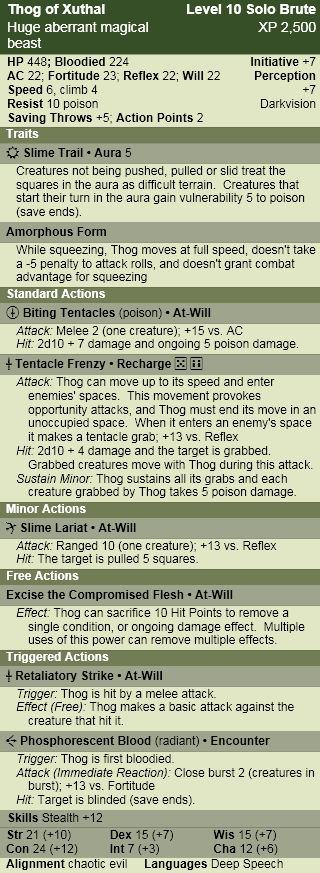
“It towered above him like a clinging black cloud. It seemed to flow about him in almost liquid waves, to envelop and engulf him… The thing seemed to be biting, clawing crushing, and clubbing him all at the same time. He felt fangs and talons rend his flesh; flabby cables that were yet hard as iron encircled his limbs and body, and worse than all, something like a whip of scorpions… tearing the skin and filling his veins with a poison that was like liquid fire.” – Robert E. Howard, The Slithering Shadow
Lore
Dungeoneering DC 20: In a sunken dome in the center of the legendary city of Xuthal, the monster known as Thog slumbers and is worshipped by the degenerate inhabitants as a god. The creature is so old that none can remember if it was brought to Xuthal by the city’s founders, or whether they unearthed it during the city’s construction.
Thog wakes at irregular intervals and stalks the secret corridors and catacombs of Xuthal, feeding on the sleeping inhabitants, who are content to await their doom in lotus dreams.
Thog of Xuthal in Combat
Thog is primarily motivated by hunger, and its preference for feeding on intelligent humanoids seems to suggest the creature needs more than just material nourishment to sustain its alien life. It attacks directly and fiercely, having lived so long it has forgotten the concept of death. In the unlikely event that Thog is gravely injured, it will retreat to its lair, where it is said there lies a well so deep it pierces the heart of the underdark.
Encounters
Thog spends much of its time in slumber, perhaps joining with its followers in one of the dream worlds the culture is so preoccupied with. Despite the creature’s predation, and even though they fear their god to the point of madness, the warriors of Xuthal protect the dome where the creature lairs and react violently to any incursion into the city from outsiders.
When hungry, Thog hunts alone, though creatures it shares a kinship with, like oozes and carrion crawlers, sometimes bubble up from the well in its lair and follow in Thog’s wake.
Notes:
My first solo monster! Many of the monsters Conan fights are solitary, but for some reason it seamed particularly appropriate for Thog to be a solo, especially given Howard’s description of it as “an aggregation of lethal creatures” (which mechanically is exactly what a solo creature is). I made it a level 10 challenge because I thought the monstrous god of a half-ruined city would be the perfect capstone to a series of heroic tier adventures.
I have to admit that creating a solo creature was difficult. Since each solo represents the xp of 5 normal creatures, there’s a lot expected out of a solo monster. I tried to follow Sly Flourish’s recommendations in ‘4 things every solo monster should have’, which I think is good advice, but may be a little heavy handed with the status effect protection. It’s true that a single daze or stun has a much greater impact on a solo encounter then it would in any other encounter, and could make a challenging fight into an unmemorable cakewalk, but take away these effects too indiscriminately and players will feel ripped off. What’s more, they’ll stop choosing those powers in favor of simple damage attacks, which also leads to boring combats (and nobody wants that). That’s why I chose to use the mechanic that I did. Challenge ruining effects can be ended, but at a cost (and only on the monster’s turn), and one I feel doesn’t leave the players feeling cheated. For the record I also think that Sly Flourish’s example is a good one, it’s just hard to apply some of the things he used to my case since he was working with an epic level monstrosity while I was looking to create a heroic challenge.
